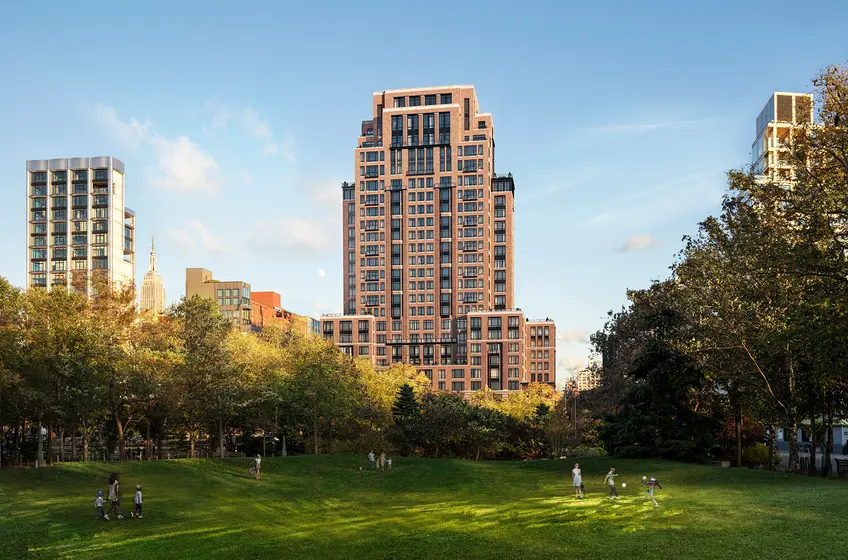 Rendering of The Cortaland from the most open section of Hudson River Park (All renderings credit of Related Companies, Olson Kundig and RAMSA via M18)
Rendering of The Cortaland from the most open section of Hudson River Park (All renderings credit of Related Companies, Olson Kundig and RAMSA via M18)
Thanks to creative thinking, West Chelsea has given us some of the best-known examples of adaptive reuse in the city. Inventive rezoning by the Bloomberg administration preserved and fostered the Chelsea Arts District as the world's largest art district of now more than 400 operating galleries. The former trans-oceanic liner berths of Chelsea Piers have been cleverly adapted into a fitness, recreational, and entertainment country club of sorts. And the stories of the High Line and Chelsea Market have become legends and inspirations all over the world, not just in New York.
As the seamstresses, writers, bird-stuffers, and those who tended the shipping industries departed, those seeking a lifestyle out of Sex and the City eventually took their place. Over the last fifteen years, new segments of the 550-acre Hudson River Park which spawned a parade of 'starchitect'-designed condos that have dramatically altered the view of Manhattan's West Side. To join Annabelle Selldorf's "Sky Garage" at 200 Eleventh, Jean Nouvel's "Vision Machine" at 100 Eleventh, and Bjarke Ingels' torqued (and troubled) twins, The Eleventh, is The Cortland, a 144-unit condominium development by Related Companies that pays tribute to the area's blue-collar heritage through its traditional design. Sales have just launched on the apartments inside.
In this article:
A spokesperson for The Cortland said that two-bedrooms start at $4.05 million and go up to four-bedrooms at over $21 million. A look at its nearest neighbors shows the building priced well above them: The one availability at 200 Eleventh Avenue is a three-bedroom for $8 million. Around the block at the Norman Foster-designed 551W21, listings range from $2.7 million for a two-bedroom to $17 million for a four-bedroom. However, The Cortland's architectural pedigree and nearly 20,000 square feet of curated amenities and services may account for the difference.
“As the neighborhood continues its transition from its history as a place of warehouses and light industrial buildings, to its future as a prime residential location, we worked to capture the romance of its recent past with a building that is at once progressive and historic” — Paul Whalen, Partner, Robert A.M. Stern Architects
The Cortland was designed by Robert A.M. Stern Architects (RAMSA) with interiors by the Seattle-based Olson Kundig. This is the first partnership between the two world-renowned firms; while RAMSA is making its mark on luxury housing throughout the city much like Rosario Candela and Emery Roth of yesteryear, The Cortland represents the first East Coast multi-unit interiors project for Olson Kundig.
Unlike its glassy, avant-garde peers, The Cortland features a classical mix of limestone, metal detailing, and over one million handmade, hand-laid bricks. A recent site visit saw large slabs of LaSalle limestone that bring classic architecture to mind; above it is a warm, “five-color brick blend” facade that makes it feel like a natural part of the neighborhood rather than a gleaming edifice dropped from outer space. Additionally, its stately entrance and rusticated limestone base would make the building seem more appropriate for a traditional residential setting — likely an intentional move to cement the area as a more established residential neighborhood, rather than one for globe-trotting loft collectors. Occupancy is estimated for summer 2022.
↓ “The building is not an object to be appreciated — it’s a home. We’ve created opportunities for residents to bring their taste and personalize their living space that invite a level of sophistication and quirkiness that suits this neighborhood” — Kirsten Ring Murray, FAIA, Design Principal, Olson Kundig
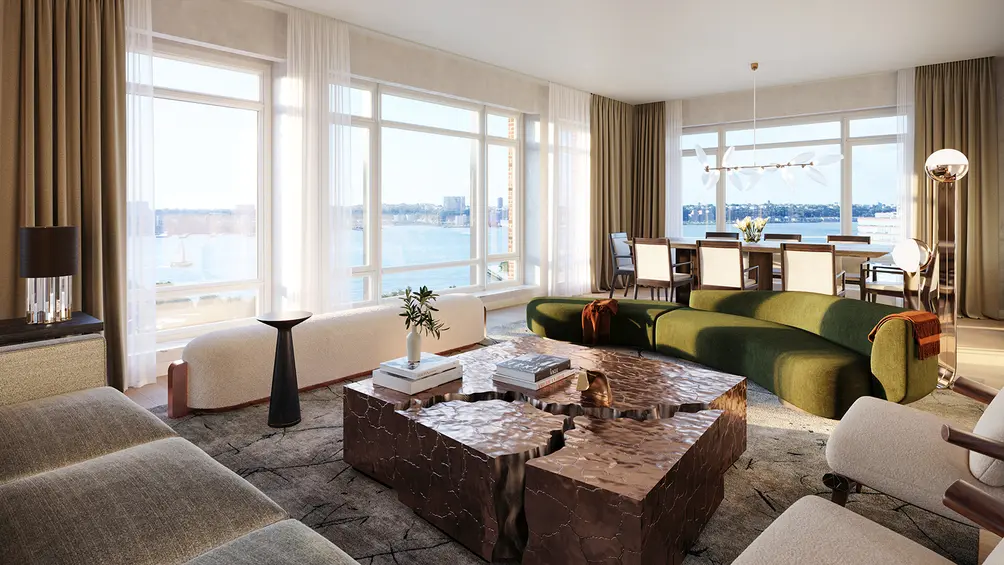
↓ All units feature high ceilings, floor-to-ceiling windows, warm wood flooring, and expansive floor plates. In what appears to be a nod to the new realities presented by the pandemic, numerous multifunctional spaces throughout the units allow for flexible living.
↓ Kitchens are finished in hand-brushed Italian lacquer and feature Statuario Belga marble countertops, as well as center islands with custom Olson Kundig Jack Boxes for storage.

↓ Select primary bedrooms feature marble fireplaces.
↓ Primary baths are lined with specialized marble from the Henraux Quarry (one of Italy’s oldest) and feature freestanding tubs, rain head showers, and radiant floor heating.
↓ The Cortland’s private brick motor court features lush landscaping and is staffed 24 hours a day, providing round-the-clock access to on-site private parking.

↓ The double-height lobby is lined with Italian marble and paldo wood, and anchored by an Olson Kundig-designed kinetic wheel-operated fireplace.

↓ The lobby's centerpiece is “Stratus,” a bronze and onyx light fixture by German sculptor Markus Haase commissioned exclusively for The Cortland.
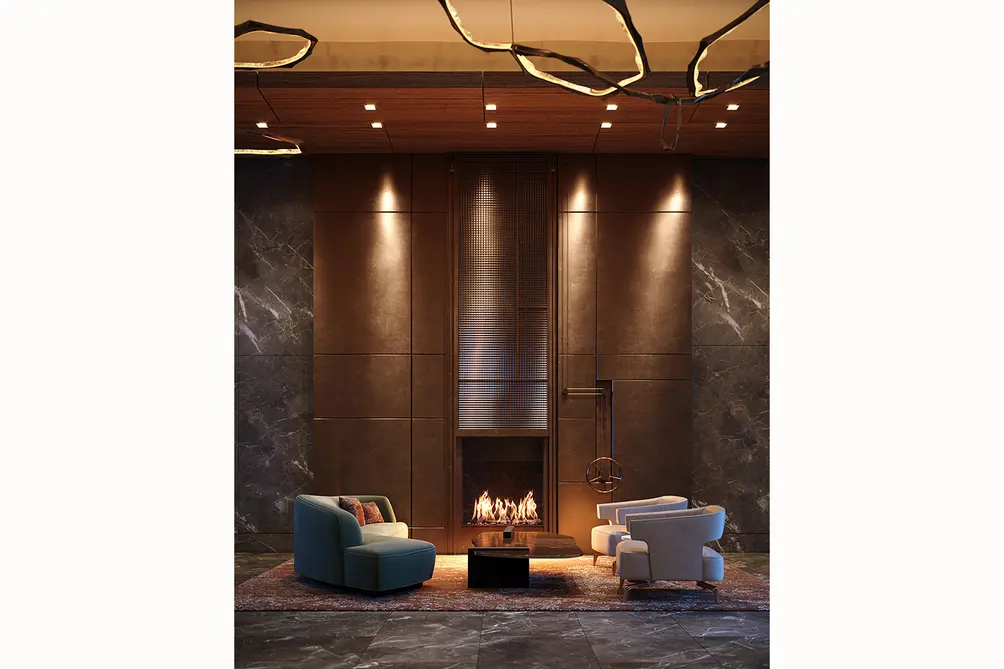
↓ The fitness center includes a high-tech gym, yoga studio, and Pilates studio.
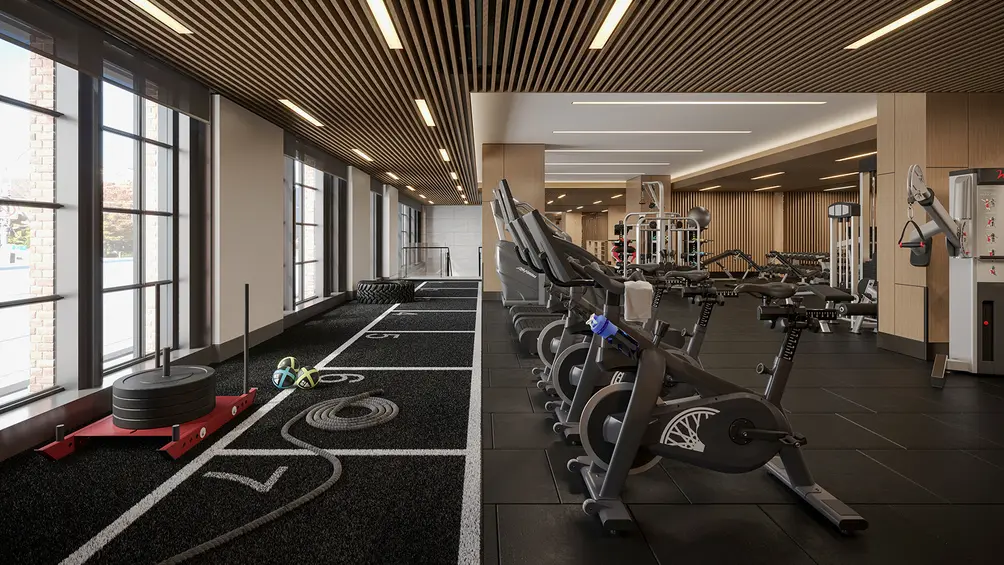

↓ In addition to a 75-foot lap pool, aquatic offerings include a child-friendly leisure pool.


↓ Spa amenities include a wood-lined treatment room as well as men’s and women’s saunas and steam rooms.


↓ Harrow Court, the building’s accredited squash court, can also be used to play basketball.

↓ The Crow’s Nest is a golf simulator lounge with a bar and sitting area.

↓ A high-tech VR room ups the amenity ante in New York City.

↓ The double-height children’s playroom is known as the Beluga Pod, and offers a rock-climbing wall and slide.

↓ A screening room with a stage doubles as a performance venue.

↓ A free-flowing event lounge features floor-to-ceiling windows, a bronze metal fireplace, and dedicated back-of-house catering kitchen.

↓ A rooftop terrace offers multiple seating and grilling areas, as well as Hudson River views.

The neighborhood between Hudson Yards and the ever-growing Google is already one of the most exciting in the city with new parks that include Little Island, Chelsea Waterside Park, and the High Line, which can be accessed on 23rd Street (best visited early morning or inebriated late evening). City Winery recently opened the city's largest wine bar at Pier 57, and the Meatpacking District with its anchoring Whitney Museum is within walking distance.
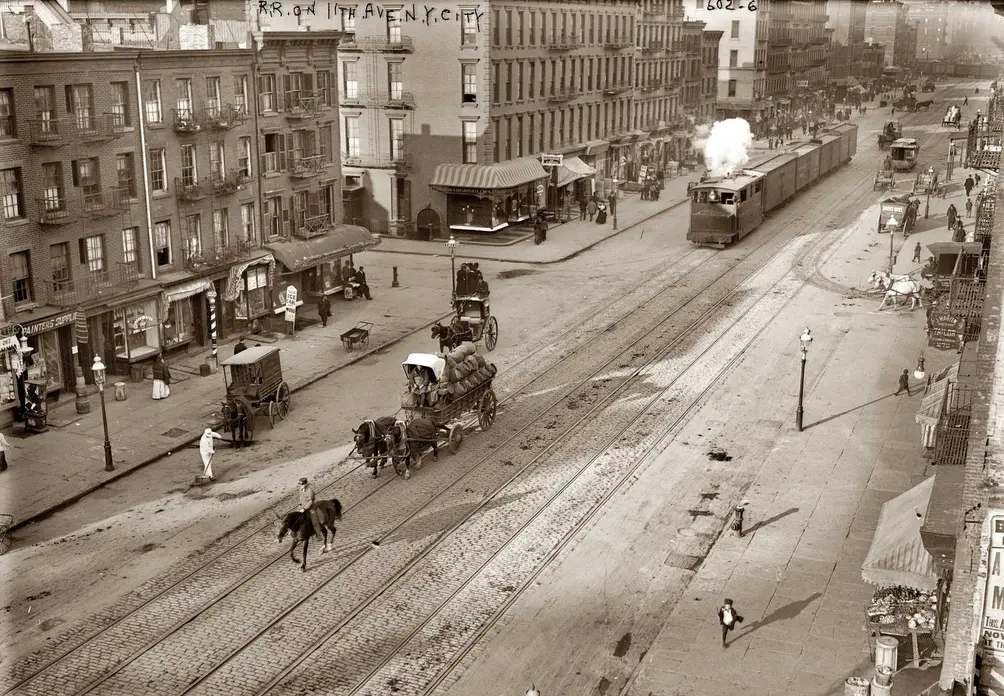 Eleventh Avenue in 1910 (Taken by Grantham Bain via Library of Congress)
Eleventh Avenue in 1910 (Taken by Grantham Bain via Library of Congress)
Indeed, Eleventh Avenue has come a long way since its early days when it was nicknamed "Death Avenue" — the time from the mid-1800s to the early 1900s when freight trains barreled down its center, mowing down hapless pedestrians and carriages as they transported precious commodities to and from the burgeoning metropolis. According to a New York Times story by David Dunlap, the League to End Death Avenue estimated that there had been 548 deaths and 1,574 injuries over the years on Eleventh Avenue. To help stem the crisis, the New York Central Railroad embarked on their own failed "Vision Zero" strategy, hiring "West Side Cowboys" to ride horses and wave flags in front of the trains to prevent collisions.
The 1929 opening of the elevated High Line made Eleventh Avenue less of a hazard to pedestrians and motorists, and the last street-level tracks were removed in 1941. Still, the west side remained unfashionable for decades as it remained a hub for the city's fading maritime industries, had lacking subway service, and offered few residential amenities. The aroma of livestock and the Meatpacking District probably didn't help either. As the city transitioned into a post-industrial economy, buildings for manufacturing, shipping, and storage gave way to nightclubs, galleries, and artist lofts. We all know what comes next.
While no longer "Death Avenue," Eleventh Avenue has some ways to go before it can be called pedestrian-friendly. A lack of bike lanes, sparse greenery, few retailers, and six lanes of traffic funneling into the West Side Highway makes it among the most hostile of Manhattan avenues. As the area continues its transitions into a Gold Coast for the well-heeled, one can expect further improvements to the public realm.
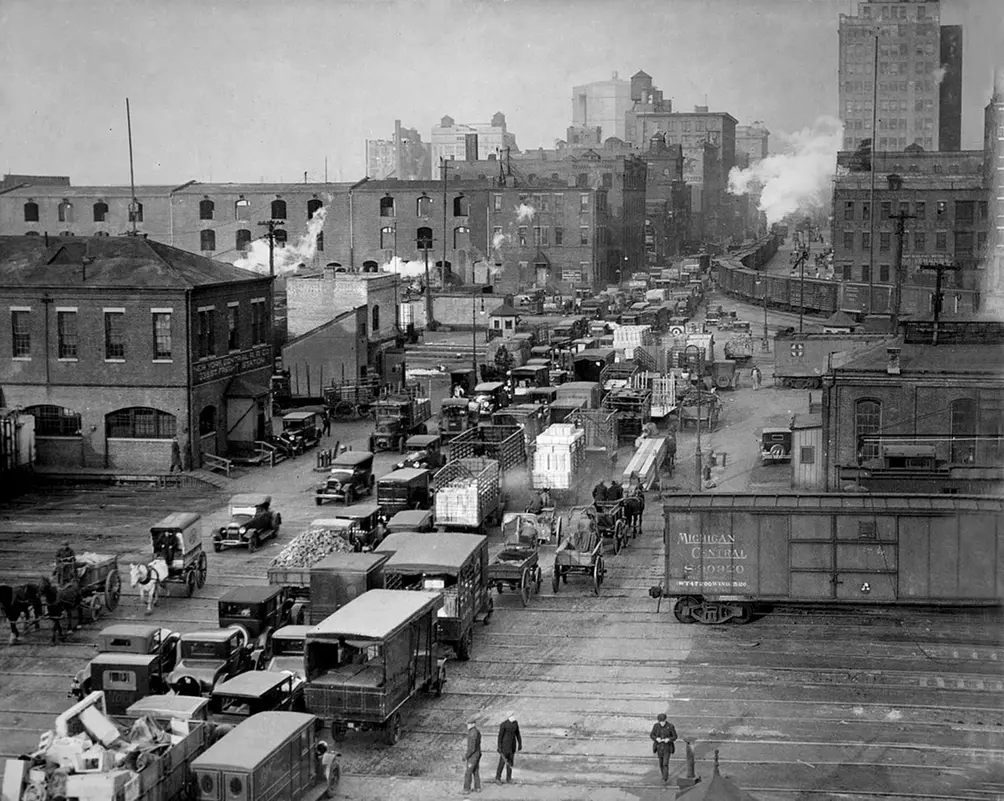 Eleventh Avenue. Yes, New York has always been chaotic, but has always sought innovative solutions to solve them. Let's continue. (Kalmbach Publishing Company)
Eleventh Avenue. Yes, New York has always been chaotic, but has always sought innovative solutions to solve them. Let's continue. (Kalmbach Publishing Company)
Would you like to tour any of these properties?

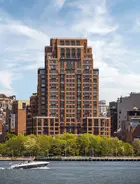
 6sqft delivers the latest on real estate, architecture, and design, straight from New York City.
6sqft delivers the latest on real estate, architecture, and design, straight from New York City.
